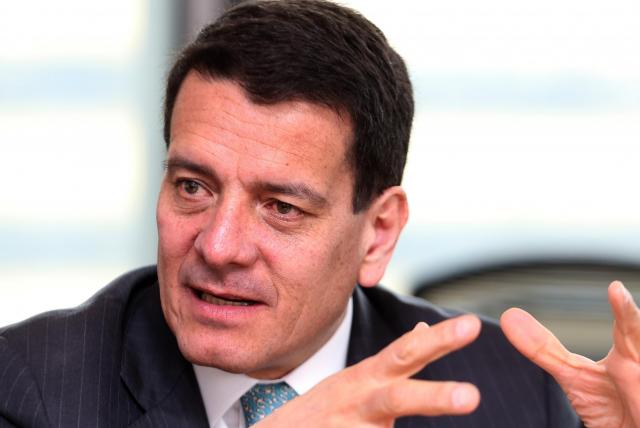
(Ecopetrol, 9.Dec.2022) — Ecopetrol S.A. (BVC: ECOPETROL; NYSE: EC) informs that its Board of Directors approved the 2023 general organic investment plan for the Ecopetrol Group for an estimated amount between COP 25.3tn and COP 29.8tn. Individual investment projects will be evaluated in due course by the Board of Directors according to their materiality. The investment plan seeks to advance the four pillars of the 2040 strategy and the roadmap for the country’s energy transition.
Highlights:
- The 2023 general investment plan (the “Investment Plan”) approved by the Board of Directors, is aligned with the Ecopetrol Group’s commitment to accelerate the energy transition path and Colombia’s energy security while maintaining competitive returns for all its shareholders in line with the 2040 strategy “Energy That Transforms”.
- Approximately 23% of the intended investments seek to cement diversification into new low-emission businesses, including investments in hydrogen production, renewable energies, carbon capture, and electricity transmission, leveraging a scale diversification at the Ecopetrol Group.
- The plan aims to reduce nearly 400,000 tons of CO2e emissions and to incorporate nearly 900 MW of renewable energy and more than 50,000 tons of green hydrogen, all by 2025.
- The commitment to gas self-sufficiency includes investments of between COP 3.6tn and 4.1tn for exploration and production projects in the Piedemonte Llanero, Continental Caribbean, and Caribbean Offshore. The plan seeks the creation of at least two new regional energy communities, and close to 107,000 new gas connections for homes.
- Close to 5.4 trillion is allocated to the electricity transmission business with the objective of enabling more than 6,000 kilometers of new transmission lines for non-conventional renewable energies by 2025.
- The hydrocarbons business foresees a production between 720 thousand and 725 thousand barrels equivalent per day in 2023, a refining throughput between 420 thousand and 430 thousand barrels per day, with transported volumes exceeding one million barrels per day, ensuring the continuity of fuel import substitution and the stability of the country’s trade balance.
- In line with the strategy’s TESG® objectives, the plan includes investments of close to COP 2.3tn in decarbonization, integrated water management, and fuel quality improvement projects, among others.
- Social investment resources for regional development and the well-being of communities amounts to COP 472bn, focused on road infrastructure, education, and access to public services such as water and gas.
- More than COP 405bn is expected to be allocated to science, technology, and innovation projects, which are essential to leverage business development and catalyze progress in technologies for the energy transition.
- The plan generates competitive returns at a Brent scenario of 80 USD/Bl, with a ROACE above 10%, EBITDA margin above 40%, and transfers to the Nation of more than COP 40tn in 2023.
The commitment to the energy transition is reflected in investments between COP 5.9tn and COP 6.8tn in renewable self-generation, hydrogen, transmission and roads, and energy efficiency; COP 3.6 to COP 4.1tn for gas self-sufficiency, and between COP 15.8tn and COP 18.9tn to ensure energy security, financial sustainability and favor the country’s trade balance.
Renewable self-generation, hydrogen, energy efficiency, carbon capture, and ISA (transmission and roads) resources represent about 23% of the investment plan for 2023. About COP 4.1tn in the next 3 years (around COP 315 billion in 2023), will allow the incorporation of 900 MW of renewable energy, produce more than 50,000 tons of low-carbon hydrogen, reduce about 400,000 tons of CO2e emissions, and advance in carbon capture and storage (CCUS) studies.
Gas investments range between COP 3.6tn and COP 4.1tn in 2023 with a production of between 174-177 thousand barrels of oil equivalent per day (which represents about 800 million cubic feet of natural gas, in addition to white products). These resources are aimed at maintaining the current supply, seeking to increase it with gas exploration projects, of which 12 wells are planned in 2023, mainly in Piedemonte, Caribbean Offshore, and Northern Colombia, consolidating social gas and energy communities as the transition fuel.
Additionally, ISA expects to invest approximately COP 6.3tn (Cop 19.8tn for the next 3 years), of which close to Cop 5.4tn is expected to be allocated to the construction of 9,657 kilometers of energy transmission by 2025 (6,227 kilometers of which will be for the transmission of non-conventional renewable energies), consolidating ISA as the Latin American leader in energy transmission.
Around 66% of the total investments projected for 2023 are expected to be allocated to projects in Colombia to continue generating added value to the domestic chain and increase the benefits for stakeholders in the country.
The investments expected to be allocated to our international operations, which correspond to 34% of the total investment, seek to secure long-term resources to fund the energy transition and continue advancing the low-emission investments, primarily in the electricity transmission business. These investments will be made in the United States, mainly in Permian (19%), as well as in Brazil (9%), Peru (3%), and Chile (3%).
In the upstream segment, the investments are expected to enable organic production levels in 2023 of between 720-725 thousand barrels of oil equivalent per day (76% oil and 24% gas and white products) and will be focused on enhanced recovery technologies to maximize the existing reservoir resources and protect the basic curve to offset the natural production decline of the fields.
Likewise, between 2023 and 2025, around 1,600 development wells are expected to be drilled, 574 of them in 2023. In 2023, 25 exploratory wells are expected to be drilled in the Llanos Orientales, Mid-Magdalena Valley, Piedemonte, and Caribbean Offshore basins.
Investments in the midstream segment represent 5% of the total 2023 investment plan, concentrating mainly on infrastructure integrity and reliability projects to be performed by Cenit, Ocensa, ODC, and ODL, and includes resources for the multipurpose pipeline expansion plan aimed at guaranteeing the national supply of refined products. The transported volumes are estimated to exceed one million barrels per day, in line with the country’s production expectations and the demand for refined products.
Investments in the downstream segment represent 7% of the estimated total for 2023 and will continue to be focused on ensuring the reliability, availability, and sustainability of the Barrancabermeja and Cartagena refineries’ operations, to strengthen the country’s energy security, energy transition, and decarbonization through the development of fuel quality and wastewater management programs that will reduce imports, ensure lower sulfur fuels and increasingly cleaner effluents. The expected combined throughput of the refineries is estimated at 420 to 430 thousand barrels per day.
Another fundamental pillar of our strategy is to Generate Value through TESG®, whereby the plan considers investments close to COP 2.3 tn mainly in projects associated with: i) decarbonization (COP896 billion), ii) integrated water management (COP 900bn), iii) fuel quality (Cop 288bn), and iv) other investments in subjects such as research, circular economy, process and industrial health and safety (COP 207bn).
Additionally, COP 472bn of social investment is planned to strengthen the commitment to local development in the regions, to leverage in 2023, among others, the intervention of 240 kilometers of tertiary networks, education for 90,000 students, access to drinking water for 16,000 inhabitants and 13,000 new users of domestic gas, among others.
To continue furthering the Cutting-Edge Knowledge pillar, the plan includes investments of COP 405bn to pursue the Science, Technology, and Innovation agenda. These investments are expected to strengthen the competitiveness of the operations and contribute to the TESG® strategy through solutions focused on the reduction of emissions and technologies that make feasible the targets of reducing water intake and zero water discharge.
The plan seeks to ensure competitive returns for the Nation and the minority shareholders, which is why, in a Brent scenario of 80 USD/Bl average for 2023, a ROACE above 10%, EBITDA margin above 40%, and solid financial results are expected to be achieved, which overcome the inflationary pressure and incorporate efficiency targets that seek to capture savings in the management of investment projects. 83% of EBITDA is generated in Colombia and transfers to the Nation including dividends, royalties and taxes would exceed COP 40tn.
Finally, the 2023 investment plan assumes, among others, self-funding of the investments, collection of the account receivable from the Fuel Price Stabilization Fund (FEPC for its Spanish acronym), and marginal leverage in line with a Gross Debt/EBITDA ratio below 2.1 times. The plan will be subject to revisions during the first quarter of 2023 based on the evolution of its assumptions.
“The Ecopetrol Group’s operating and commercial figures in 2022 evidence an outstanding performance that supports the historic financial results. With the 2023 investment plan, we will continue to grow with the energy transition, while generating value for society and our shareholders, and ratifying the Group’s commitment to TESG® and the country’s energy security,” said Ecopetrol’s president, Felipe Bayón Pardo.
____________________

